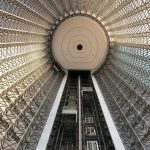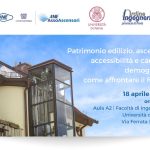The Pole House: an Australian icon
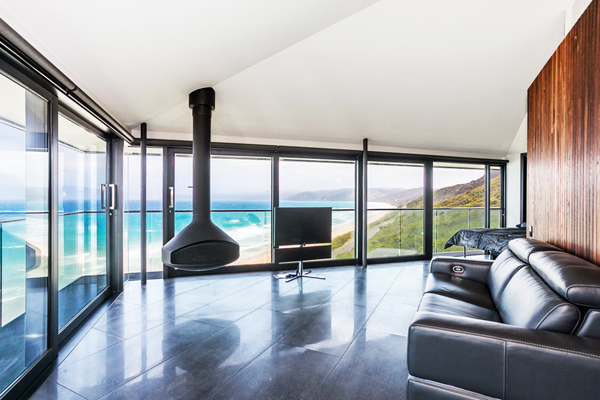 “Do not call it home. Pole House is an experience”. There is a number of reviews on the Internet and most of them are enthusiastic. Some people travel to Australia in order to spend the holidays in the most photographed residence of the Great Ocean Road, the famous 253 km scenic road south of Melbourne (Victoria, Australia). The key to the story will be the lift, which however cannot live outside of the context and life of people who use it.
“Do not call it home. Pole House is an experience”. There is a number of reviews on the Internet and most of them are enthusiastic. Some people travel to Australia in order to spend the holidays in the most photographed residence of the Great Ocean Road, the famous 253 km scenic road south of Melbourne (Victoria, Australia). The key to the story will be the lift, which however cannot live outside of the context and life of people who use it.
Let’s see what it is.
FOREWORD
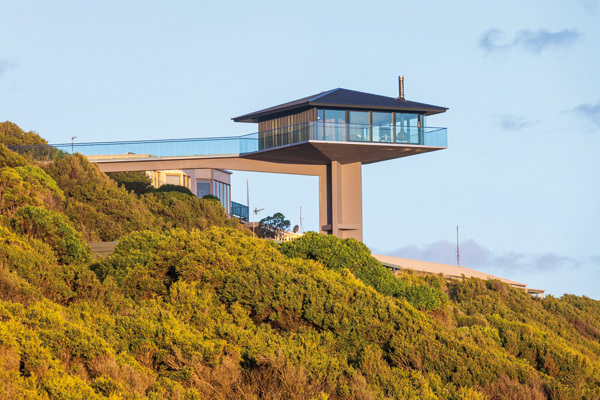 The Pole House is a special residence offering one of the most impressive views of the Australian coast; this is the chosen destination for surfers from around the world. Adjacent to it, projecting into the sea, a completely independent house overlooking the beach. Originally, the Pole House enjoyed the charm coming mainly from its “iconic” value. It was a peculiar place, with an ethnic décor which did not take fully advantage of the wonderful landscape. Today, the interior design features a minimalist style accommodating the different shades of light during the whole day. In the 70s, however, there were no opening windows, the lighting was artificial (with orange ball chandeliers) and Berber carpets were hanging on the walls. The environment could appear as “claustrophobic” despite the surrounding landscape.In the 2000s, the intervention of the architects was radical and revolutionary. The Pole House (and not only) was modernised and re-interpreted according to the wishes of the new owners: “bringing the old Seventies icon into the 21st century”.The goal was achieved by “fully redesigning the interiors to maximize the 180-degree views stretching from Split Point Light House to Lorne and beyond. Moreover, instead of the old wooden house, we wanted to build a large house overlooking the beach, separated from the Pole House, so that this latter could offer independently a view on the landscape”. (Studio F2 Architecture)
The Pole House is a special residence offering one of the most impressive views of the Australian coast; this is the chosen destination for surfers from around the world. Adjacent to it, projecting into the sea, a completely independent house overlooking the beach. Originally, the Pole House enjoyed the charm coming mainly from its “iconic” value. It was a peculiar place, with an ethnic décor which did not take fully advantage of the wonderful landscape. Today, the interior design features a minimalist style accommodating the different shades of light during the whole day. In the 70s, however, there were no opening windows, the lighting was artificial (with orange ball chandeliers) and Berber carpets were hanging on the walls. The environment could appear as “claustrophobic” despite the surrounding landscape.In the 2000s, the intervention of the architects was radical and revolutionary. The Pole House (and not only) was modernised and re-interpreted according to the wishes of the new owners: “bringing the old Seventies icon into the 21st century”.The goal was achieved by “fully redesigning the interiors to maximize the 180-degree views stretching from Split Point Light House to Lorne and beyond. Moreover, instead of the old wooden house, we wanted to build a large house overlooking the beach, separated from the Pole House, so that this latter could offer independently a view on the landscape”. (Studio F2 Architecture)
THE PROJECT
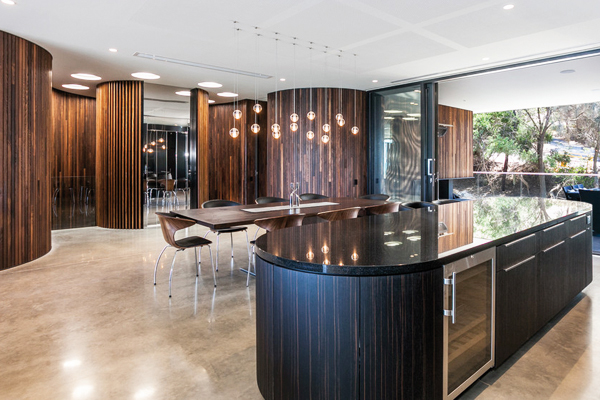 Thanks to the collaboration with Easy Living Home Elevators (the Australian company in charge of the design and installation of the lifting platform DomusLift, see par. 3), the designers (Franco Fiorentini, architect, and Vivienne Mackley, interior designer from Studio F2 Architecture) tell about the key driving ideas for the modernisation/reconstruction works and what was carried out.“The Pole House was a wooden structure with a roof made of concrete tiles. The decorations were kitsch 70s style. It gave the feeling of a comfortable tree house: cosy, but without opening windows, except for the entrance sliding door. In the same property, behind the Pole House, there was also a small and very simple wooden house, including a bedroom, a closet, a bathroom and a shed for four parking spaces”. As for the works the designers say “The Pole House was completely renovated using steel and glass. The interiors were fully redesigned and opened outwards. The two sides today can retract and open towards the ocean. Inside the house, a fantastic suspended fireplace allowing to sit in front of the fire while contemplating the ocean. This was a specific owners’ request”. The Pole House includes one bedroom, one bathroom, a living area and a kitchen area. While the new house overlooking the beach, with a minimalist style in steel, glass and concrete, located on the site of the old house, includes three bedrooms, three bathrooms and a large open kitchen. The living room offers views over the 6km Fairhaven beach, the longest stretch of beach of the Surf Coast. The two houses can accommodate a total of eight persons.
Thanks to the collaboration with Easy Living Home Elevators (the Australian company in charge of the design and installation of the lifting platform DomusLift, see par. 3), the designers (Franco Fiorentini, architect, and Vivienne Mackley, interior designer from Studio F2 Architecture) tell about the key driving ideas for the modernisation/reconstruction works and what was carried out.“The Pole House was a wooden structure with a roof made of concrete tiles. The decorations were kitsch 70s style. It gave the feeling of a comfortable tree house: cosy, but without opening windows, except for the entrance sliding door. In the same property, behind the Pole House, there was also a small and very simple wooden house, including a bedroom, a closet, a bathroom and a shed for four parking spaces”. As for the works the designers say “The Pole House was completely renovated using steel and glass. The interiors were fully redesigned and opened outwards. The two sides today can retract and open towards the ocean. Inside the house, a fantastic suspended fireplace allowing to sit in front of the fire while contemplating the ocean. This was a specific owners’ request”. The Pole House includes one bedroom, one bathroom, a living area and a kitchen area. While the new house overlooking the beach, with a minimalist style in steel, glass and concrete, located on the site of the old house, includes three bedrooms, three bathrooms and a large open kitchen. The living room offers views over the 6km Fairhaven beach, the longest stretch of beach of the Surf Coast. The two houses can accommodate a total of eight persons.
THE VERTICAL TRANSPORT
The lifting platform
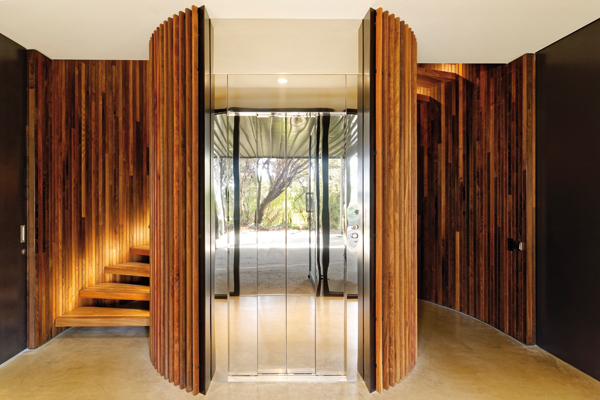 In order to ease the movements within the “beach house”, adjacent to the Pole House, a DomusLift lifting platform, by the Italian company IGV Group Spa, was installed, manufactured on a bespoke design by the Australian Easy Living Home Elevators. In details, the model features:
In order to ease the movements within the “beach house”, adjacent to the Pole House, a DomusLift lifting platform, by the Italian company IGV Group Spa, was installed, manufactured on a bespoke design by the Australian Easy Living Home Elevators. In details, the model features:
- rated load: 400 kg;
- 2 stops;
- 2 entrances;
- travel = 3,200 mm;
- 0.3 m/s speed;
- hydraulic motor.
Car dimensions: 1,100 mm (width) x 1,250 mm (depth) x 2,000 mm (height). Automatic sliding doors.
Finishes
The car profiles are natural anodized aluminium, while the car pushbutton panel is brushed stainless steel. The light is provided by LED lights with chrome rings embedded in a white ceiling.The car outer cladding was made of wood in warm earth shades. The doors are in mirror steel in order to emphasize the minimalist choice.Interesting and in tune with the latest architectural theories on the building/vertical transportation relationship1 is the idea of the property owners who were asked about reasons for their choice of materials and which atmosphere they wanted to create.
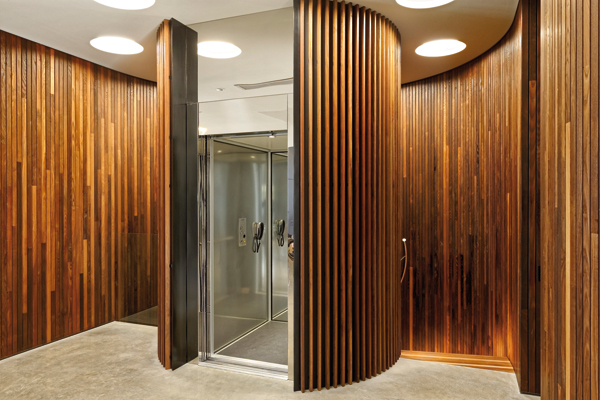
“We wanted to evoke a sophisticated and luxurious atmosphere. The monochrome environment was the most suitable for the natural light nuances during the various moments of the day. We also wanted to give a prominent role to the lift.
The goal was achieved by placing the lift in the centre of the living room, instead of hiding it in a corner, as usual”.Matteo Volpe, the General Director of IGV Group, leading company in the manufacture of DomusLift systems (one of the symbols of the Made in Italy in the world) emphasises this concept.He says that the lift (or lifting platform, in this case) can be considered as an element of furniture, thanks to the wide choice of finishes, and an element of the architectural space inside the house. “The Pole House is a good example of the way a lifting platform is a versatile system: meeting the user and environment needs while complying with aesthetic requirements and also creating original space solutions”. The Pole House is a unique experience for travellers wanting to enrich their journey enjoying a stay in an iconic resort of the Australian landscape.
Home project
Architect: F2 Architecture – Franco Fiorentini
Interior designer: F2 Architecture – Vivienne Mackley
Builder: GD Construction – George Dragovitch
DomusLift: IGV Group SpA (Milan, Italy), Easy Living Home Elevators (Australia)
Materials/Details
Flooring: Polished Concrete and Tiles
Walls Exterior: Steel Frame, Steel Cladding, Concrete Blocks
Walls Interior: Plaster and Wood Paneling
Lighting: LED Controlled Thru Dynalite System
Windows + External Doors: Steel Frames and Viridian Glass
Outdoor: Steel Frame, Steel Cladding and Concrete
Source: IGV Group Spa, www.igvlift.com, www.domuslift.com (Italy);
Easy Living Home Elevators, www.easy-living.com.au (Australia).
The author thanks Easy Living Home Elevators for their support.
by Federica Villa


